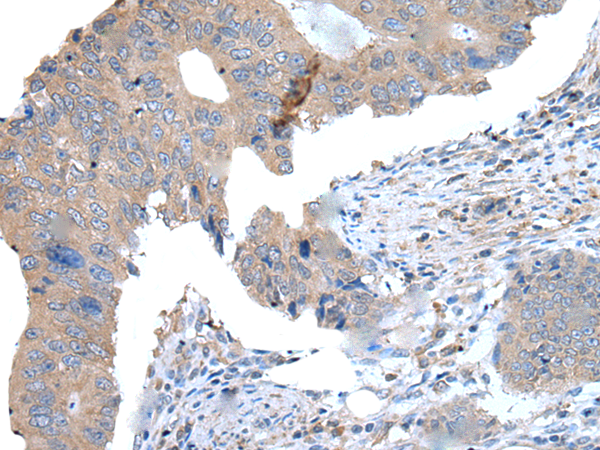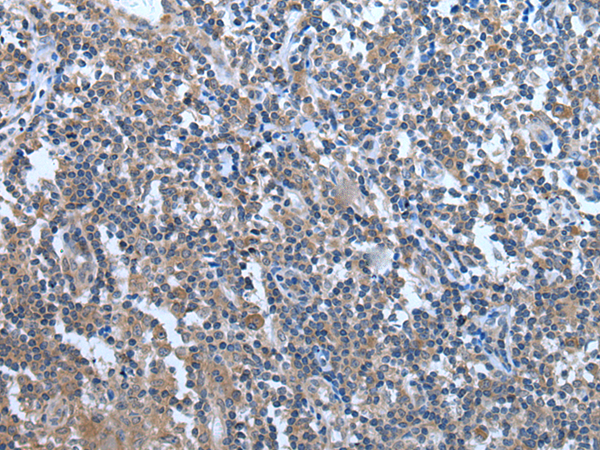


| WB | 咨询技术 | Human,Mouse,Rat |
| IF | 咨询技术 | Human,Mouse,Rat |
| IHC | 1/25-1/100 | Human,Mouse,Rat |
| ICC | 技术咨询 | Human,Mouse,Rat |
| FCM | 咨询技术 | Human,Mouse,Rat |
| Elisa | 1/5000-1/10000 | Human,Mouse,Rat |
| Aliases | DR11; HH14; BRWD2; WDR15 |
| WB Predicted band size | 137 kDa |
| Host/Isotype | Rabbit IgG |
| Antibody Type | Primary antibody |
| Storage | Store at 4°C short term. Aliquot and store at -20°C long term. Avoid freeze/thaw cycles. |
| Species Reactivity | Human |
| Immunogen | Synthetic peptide of human WDR11 |
| Formulation | Purified antibody in PBS with 0.05% sodium azide and 50% glycerol. |
+ +
以下是3篇涉及WDR11抗体的关键文献摘要信息,供参考:
---
1. **文献名称**:WDR11 mediates Hedgehog signaling-dependent regulation of ciliary homeostasis
**作者**:Kim J et al.
**摘要**:该研究通过免疫共沉淀和免疫荧光技术,利用WDR11抗体揭示其在纤毛形成中调控Hedgehog信号通路的作用机制。发现WDR11缺失导致纤毛结构异常,并与Gli转录因子共定位,提示其在发育疾病中的潜在病理关联。
---
2. **文献名称**:Mutations in WDR11 are associated with hypogonadotropic hypogonadism and olfactory defects
**作者**:Sato N et al.
**摘要**:研究通过Western blot和免疫组化(使用兔源WDR11多克隆抗体),发现WDR11基因突变导致卡尔曼综合征患者的促性腺激素分泌不足。实验证明WDR11与EMX1转录因子相互作用,参与下丘脑神经元发育调控。
---
3. **文献名称**:WD Repeat Protein WDR11 coordinates with retinoic acid receptor to regulate gene expression during neurulation
**作者**:Xu C et al.
**摘要**:利用WDR11抗体进行ChIP-seq分析,揭示其与视黄酸受体(RAR)协同调控神经管闭合相关基因。研究发现WDR11作为染色质重塑复合体的组分,通过组蛋白修饰影响胚胎发育关键通路。
---
**备注**:若需具体实验细节(如抗体货号、应用场景),建议通过PubMed或抗体供应商数据库(如CiteAb)检索抗体引用文献。
The WDR11 antibody is a research tool designed to detect the WDR11 (WD repeat-containing protein 11) protein, a member of the WD-repeat protein family characterized by conserved structural motifs involved in protein-protein interactions. WDR11 plays critical roles in ciliogenesis, Hedgehog signaling, and neuronal development, with genetic links to Kallmann syndrome (a disorder combining hypogonadism and anosmia) and congenital hypogonadotropic hypogonadism. It interacts with key regulators like EMX1 and USP7. influencing transcription, cell cycle progression, and post-translational modifications. Dysregulation of WDR11 is also implicated in cancers, including prostate and breast cancer.
Antibodies targeting WDR11 are widely used in techniques such as Western blotting, immunohistochemistry, and immunofluorescence to study its expression, subcellular localization (e.g., cytoplasmic vs. nuclear distribution), and functional interactions in disease models. These antibodies aid in exploring WDR11's role in developmental disorders, reproductive health, and tumorigenesis. Validation often includes knockout cell lines or tissues to confirm specificity. As research advances, WDR11 antibodies remain essential for deciphering its molecular mechanisms and therapeutic potential in associated pathologies.
×